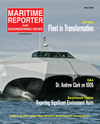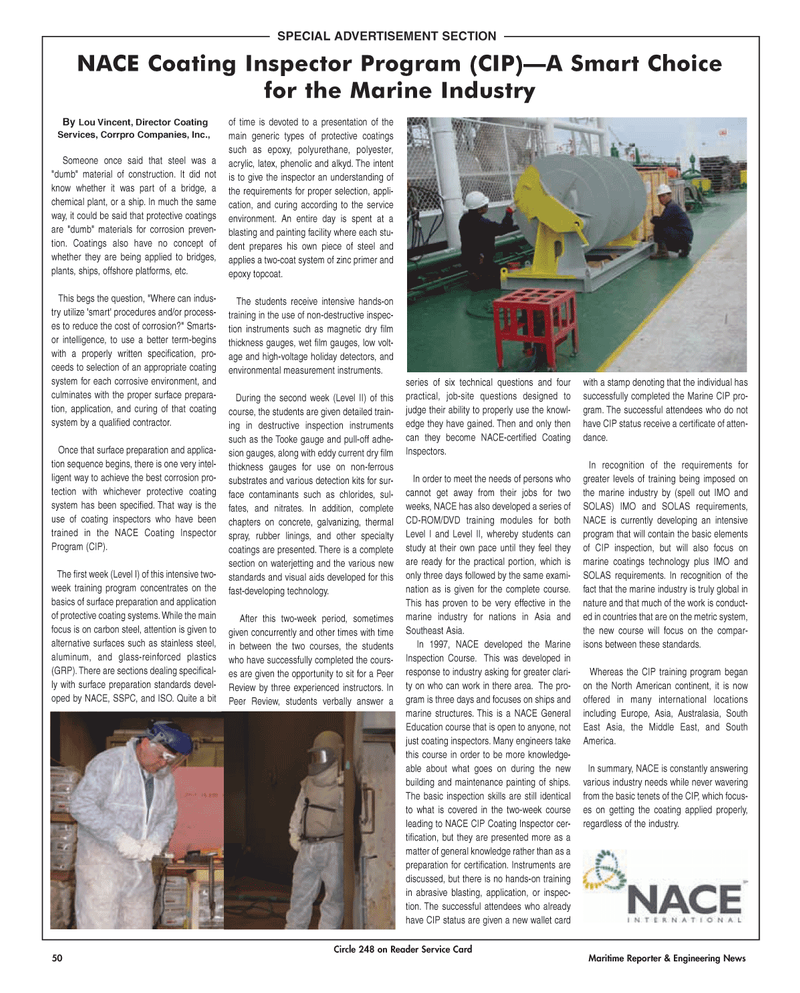
Page 50: of Maritime Reporter Magazine (March 2006)
The Training & Education Edition
Read this page in Pdf, Flash or Html5 edition of March 2006 Maritime Reporter Magazine
50 Maritime Reporter & Engineering News
SPECIAL ADVERTISEMENT SECTION
By Lou Vincent, Director Coating
Services, Corrpro Companies, Inc.,
Someone once said that steel was a "dumb" material of construction. It did not know whether it was part of a bridge, a chemical plant, or a ship. In much the same way, it could be said that protective coatings are "dumb" materials for corrosion preven- tion. Coatings also have no concept of whether they are being applied to bridges, plants, ships, offshore platforms, etc.
This begs the question, "Where can indus- try utilize 'smart' procedures and/or process- es to reduce the cost of corrosion?" Smarts- or intelligence, to use a better term-begins with a properly written specification, pro- ceeds to selection of an appropriate coating system for each corrosive environment, and culminates with the proper surface prepara- tion, application, and curing of that coating system by a qualified contractor.
Once that surface preparation and applica- tion sequence begins, there is one very intel- ligent way to achieve the best corrosion pro- tection with whichever protective coating system has been specified. That way is the use of coating inspectors who have been trained in the NACE Coating Inspector
Program (CIP).
The first week (Level I) of this intensive two- week training program concentrates on the basics of surface preparation and application of protective coating systems. While the main focus is on carbon steel, attention is given to alternative surfaces such as stainless steel, aluminum, and glass-reinforced plastics (GRP). There are sections dealing specifical- ly with surface preparation standards devel- oped by NACE, SSPC, and ISO. Quite a bit of time is devoted to a presentation of the main generic types of protective coatings such as epoxy, polyurethane, polyester, acrylic, latex, phenolic and alkyd. The intent is to give the inspector an understanding of the requirements for proper selection, appli- cation, and curing according to the service environment. An entire day is spent at a blasting and painting facility where each stu- dent prepares his own piece of steel and applies a two-coat system of zinc primer and epoxy topcoat.
The students receive intensive hands-on training in the use of non-destructive inspec- tion instruments such as magnetic dry film thickness gauges, wet film gauges, low volt- age and high-voltage holiday detectors, and environmental measurement instruments.
During the second week (Level II) of this course, the students are given detailed train- ing in destructive inspection instruments such as the Tooke gauge and pull-off adhe- sion gauges, along with eddy current dry film thickness gauges for use on non-ferrous substrates and various detection kits for sur- face contaminants such as chlorides, sul- fates, and nitrates. In addition, complete chapters on concrete, galvanizing, thermal spray, rubber linings, and other specialty coatings are presented. There is a complete section on waterjetting and the various new standards and visual aids developed for this fast-developing technology.
After this two-week period, sometimes given concurrently and other times with time in between the two courses, the students who have successfully completed the cours- es are given the opportunity to sit for a Peer
Review by three experienced instructors. In
Peer Review, students verbally answer a series of six technical questions and four practical, job-site questions designed to judge their ability to properly use the knowl- edge they have gained. Then and only then can they become NACE-certified Coating
Inspectors.
In order to meet the needs of persons who cannot get away from their jobs for two weeks, NACE has also developed a series of
CD-ROM/DVD training modules for both
Level I and Level II, whereby students can study at their own pace until they feel they are ready for the practical portion, which is only three days followed by the same exami- nation as is given for the complete course.
This has proven to be very effective in the marine industry for nations in Asia and
Southeast Asia.
In 1997, NACE developed the Marine
Inspection Course. This was developed in response to industry asking for greater clari- ty on who can work in there area. The pro- gram is three days and focuses on ships and marine structures. This is a NACE General
Education course that is open to anyone, not just coating inspectors. Many engineers take this course in order to be more knowledge- able about what goes on during the new building and maintenance painting of ships.
The basic inspection skills are still identical to what is covered in the two-week course leading to NACE CIP Coating Inspector cer- tification, but they are presented more as a matter of general knowledge rather than as a preparation for certification. Instruments are discussed, but there is no hands-on training in abrasive blasting, application, or inspec- tion. The successful attendees who already have CIP status are given a new wallet card with a stamp denoting that the individual has successfully completed the Marine CIP pro- gram. The successful attendees who do not have CIP status receive a certificate of atten- dance.
In recognition of the requirements for greater levels of training being imposed on the marine industry by (spell out IMO and
SOLAS) IMO and SOLAS requirements,
NACE is currently developing an intensive program that will contain the basic elements of CIP inspection, but will also focus on marine coatings technology plus IMO and
SOLAS requirements. In recognition of the fact that the marine industry is truly global in nature and that much of the work is conduct- ed in countries that are on the metric system, the new course will focus on the compar- isons between these standards.
Whereas the CIP training program began on the North American continent, it is now offered in many international locations including Europe, Asia, Australasia, South
East Asia, the Middle East, and South
America.
In summary, NACE is constantly answering various industry needs while never wavering from the basic tenets of the CIP, which focus- es on getting the coating applied properly, regardless of the industry.
NACE Coating Inspector Program (CIP)—A Smart Choice for the Marine Industry
Circle 248 on Reader Service Card
MR MARCH2006 #7 (49-57).qxd 3/2/2006 2:15 PM Page 50

 49
49

 51
51
